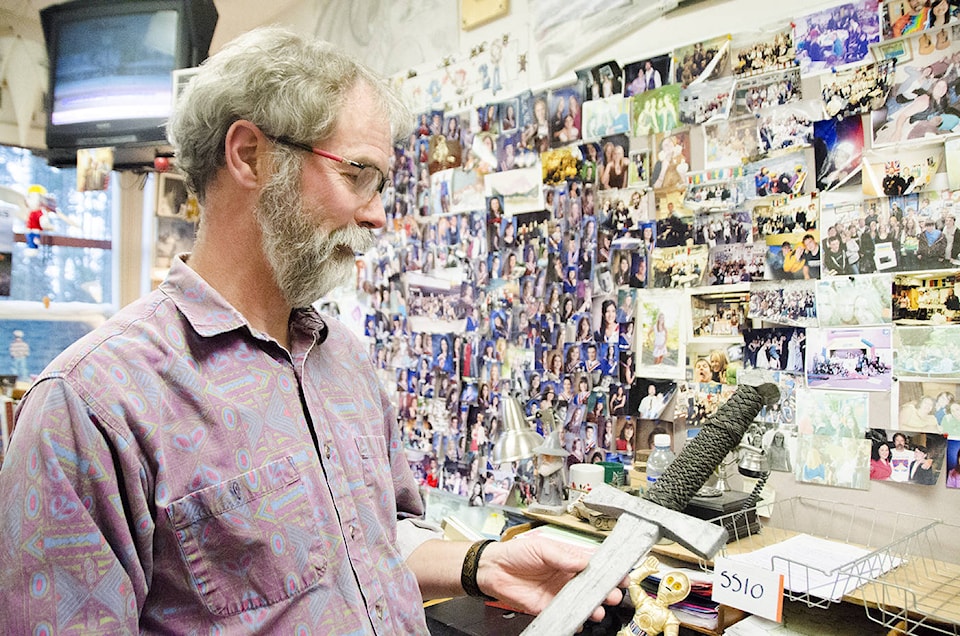When Timberline Secondary teacher Steve Joyce looks up at the wall behind his desk, he sees the smiling faces of students who have gone through his Outdoor Adventure Program throughout its 20 years on offer at the school.
There are doctors and lawyers and nurses and accountants and graphic designers and, yes, even a few outdoor guides.
He keeps in touch with most of them to this day. One of them called him just last month to see if he’d be a reference for them for an application of some sort.
Because that’s what his program does. It breeds life-long connections for kids – to each other, to their teacher and to the natural world.
Outdoor Adventure is a semester-long program that is made up of four individual curriculums rolled into an experience.
“We spend a large chunk of five months in the wilderness,” he says. The class does seven trips each semester and while each of their trips adapt aspects of their coursework to specifically reflect that area – the Geography 12 curriculum, for example, focuses on coastal land forms when they go to Cape Scott and geomorphology and glaciation when they go to Strathcona Park – they also learn a huge amount about appreciating the wonderful natural world around us, how to work as a team and create lasting memories and skills that last a lifetime.
But while they are on those trips, learning all those amazing things, there’s a lot of downtime. For years, there were three separate “courses” contained within the program for which the students got graduation requirement credit, but there was something missing, Joyce says.
He stumbled across a program being run at a high school in Prince George, found the answer he was looking for, and asked the Campbell River School District if he could add Middle Earth 12 to the program.
“What I found over the last little while was a disturbing trend,” Joyce says. “Children aren’t reading like they used to. That bothered me, so when I saw the program up in Prince George, I thought, ‘this is great, because they can drag a book along with them when we go out into the woods or whatever.’ I mean, imagine you’re reading Lord of the Rings in this amazing cathedral of forests on Cape Scott. What a thematic area to absorb what you’re reading, and then we go sit down at the beach and discuss what everyone is reading and share our thoughts on it all and expand our minds even more.”
The course was incorporated into the adventure program last fall for the first time after being approved by the district last spring. After just one running of the curriculum, Joyce knows it will be a success long-term.
While the course is called Middle Earth 12, it’s not a study of the iconic works produced by J.R.R Tolkien – as you might expect from hearing the name – although it is structured that way, broken down into sections.
Section one is entitled “Setting Out on the Quest,” where they explore the “why” of what they are doing, how it will be done and begin to explore symbolism, word origins, and the idea of myth and legend.
Section two is called “Exploring New Lands,” where they look at medievalism structures in literature and culture, real and invented architecture, styles of cartography (map making), as well as the history of famous stories and authors.
Then they get into section three, which is “Coming Home From the Journey.” This section involves independent research into additional topics of the students’ choice, film studies and, best of all, a “Year-End Feast,” where each student brings food found in a a work of fiction.
The end goal, Joyce says, is for the students to not only develop a love for the written word, but also engage with the idea of writing some of their own.
This year’s final assignment was to write a book, in fact.
“Next year, we’re going to modify it and I’m going to have them write a short story per month instead,” he says with a chuckle. “The book idea was good, and a few students totally bought in, but it was sort of all-encompassing and massive and intimidating. With short stories, the kids can really get their heads around and allows them to try different things and go in different directions.”
The idea, as with everything Joyce teaches, is for him – along with his educational assistant Suzy Scott – to give them the tools they need, and let them explore the world on their own.
“We need to give them the root and then ask them to choose their own direction. In our society we tend to direct kids too much,” he says, which might have been great when we were preparing them to work in a manufacturing society, where they were being prepared to go work on an assembly line in a factory of some kind, “but now we need free thinkers. We need people to be more flexible and more resilient when they get out there. This challenges them to try to find their own path.”
Just like Frodo.
“And in the end, the reward is much larger, because they’re the ones who have created that path.”
